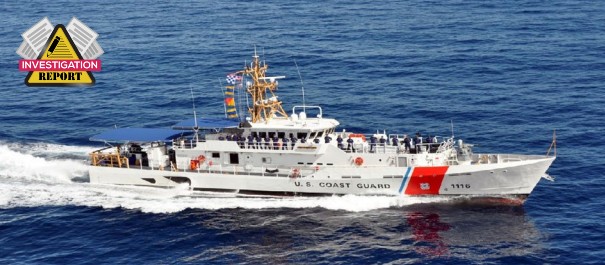The National Transportation Safety Board (NTSB) has issued an investigation report, on collision between US Coast Guard Cutter Winslow Griesser and Center-console Boat Desakata.
On August 8, 2022, about 1417 local time, the 154-foot-long US Coast Guard cutter Winslow Griesser (WPC-1116) and the 23-foot-long center-console boat Desakata collided about 4 miles off the northern coast of Puerto Rico. The cutter, with a crew of 21, was transiting westbound along the coast, and the boat was transiting northbound while trolling (fishing). Of the two Desakata crewmembers, one was seriously injured, and one was fatally injured. None of the Winslow Griesser crewmembers were injured. No pollution was reported. The Desakata, valued at $58,800, was a total loss.
The Winslow Griesser was scheduled to get underway from Coast Guard Base San Juan, Puerto Rico, at 0830 on August 8, 2022. The cutter’s destination was Punta Cana, Dominican Republic, to pick up two Dominican naval officers for a routine patrol in and around the Mona Passage, a strait that separates the islands of Hispaniola (where the Dominican Republic is located) and Puerto Rico. The crew held a navigation brief at 0800, during which the crew used their prescribed risk management tool, called GAR 2.0, to assess their risk for the transit. They assessed the risk as low. During pre-underway checks, the crew discovered a loss of pressure in the propulsion engine-cooling seawater system, and the trip was delayed while crewmembers resolved the issue. Once the engines were started, the bridge team and other watch station personnel on the vessel conducted short refresher navigation and risk assessment briefs. The cutter got underway at 1335.
While the cutter was getting underway, extra crewmembers (known as a special sea detail) were added to the normal bridge watchstanding team for the
vessel’s transit out of port. The bridge watchstanders consisted of an officer of the deck, conning officer, navigation evaluator, and quartermaster of the watch.
At 1345, as the vessel exited San Juan harbor, personnel assumed their normal at-sea watches. During normal at-sea operations, bridge watches aboard the
Winslow Griesser consisted of an officer of the deck and a quartermaster of the watch.
The crewmember who had been the navigation evaluator assumed duties as officer of the deck. The quartermaster of the watch remained on watch. The executive officer, who had been the conning officer while the cutter maneuvered out of port, went below, while the commanding officer, though not on watch, remained on the bridge. The cutter’s training petty officer, who had transferred recently and was working toward his quartermaster of the watch qualification, helped secure the deck, fenders, and flags, and then he arrived on the bridge for training. A visiting port engineer shadowed the officer of the deck as he explained the uses of various bridge equipment including the helm station. She was aboard for familiarization and was working on naval engineering qualifications, which required, among other things, experience as a deck watch officer.
At 1350, once clear of shoal water, on the west side of the San Juan harbor approach, the bridge team altered the cutter’s course to a northwesterly direction
and increased speed from 15 to 29 knots. The automatic identification system (AIS) transmitter was secured at 1353, after the vessel exited restricted waters, in
accordance with the vessel’s checklist for getting underway (the cutter did not transmit AIS due to its law enforcement mission). About 1406, the bridge team again altered the cutter’s course to port, closer to a westerly course.
During the investigation, the Winslow Griesser commanding officer, officer of the deck, and quartermaster of the watch declined requests of National
Transportation Safety Board investigators to be interviewed based on advice of their counsel. The Winslow Griesser been equipped with a voyage data recorder, or its equivalent, investigators would have been provided with additional critical factual information about the collision, which could help identify potential safety issues and result in safety improvements.
Probable Cause
The National Transportation Safety Board determines that the probable cause of the collision between the US Coast Guard cutter Winslow Griesser and the
center-console boat Desakata was the failure by both vessels’ crews to maintain a proper lookout. Contributing to the casualty was the Winslow Griesser commanding officer and officer of the deck not taking sufficient measures to increase situational awareness while transiting at a high speed.
Lessons learned
Lessons learned from tragedies like this collision can be useful as training tools and for reviewing current watchstanding (in particular lookout) practices to identify weaknesses and find areas for improvement. Therefore, NTSB recommended that the Coast Guard provide information about the circumstances of this collision to cutter crews and emphasize the importance of maintaining a proper lookout and ensuring situational awareness when transiting at high speed. Charged by Congress as the only independent investigator of Coast Guard casualties, the NTSB requires the availability of objective, time-stamped data, such as that provided by a voyage data recorder, to complete timely and thorough investigations that involve Coast Guard cutters.
Voyage data recorders are one of the most valuable sources of information following a marine casualty because they maintain continuous, sequential records of data relating to a ship’s equipment and its command and control, and they also capture bridge audio. Although investigators gathered vital information from camera footage, interviews with crewmembers not on watch, and other sources, the presence of a voyage data recorder on board the Winslow Griesser would have provided access to additional critical data. Therefore, NTSB recommended that the Coast Guard install equipment on all cutters that records vessel parametric data and audio information that is equivalent to International Maritime Organization voyage data recorder performance standards.





























































